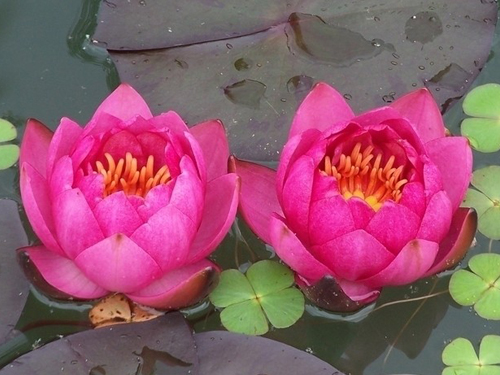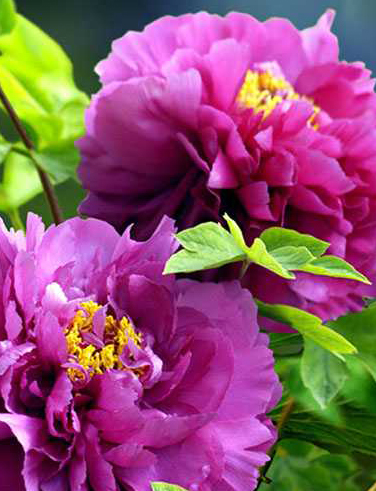What are the common cultivated varieties of Hemerocallis
Day lilies are called cauliflower. The flower color is yellowish to orange, in the form of a wide funnel, flowering from May to September.
At present, the widely cultivated ones are:
1. Hemerocallis. Panicle-shaped Cymes, each with 6-12 flowers, flowers 7-11 cm long, petal margin wrinkled, orange to orange, with reddish-brown spots on the lower part of the lobes. When the flowers are in full bloom, the petals roll back, and the flowering period is from May to August.
2. Double day lily. Named Hemerocallis hemerocallis. The flowers are large, up to 8 cm in diameter, yellowish, with orange inner petals. There are pure yellow, golden, dark red and magenta, purple and other spots on the petals of horticultural varieties.
3. Lemon Hemerocallis. It's called cauliflower. The flower is light lemon yellow, tastes light and fragrant, and has many flowers. The florescence is from July to August. A single flower blooms at dusk and closes before noon the next day.
4. North cauliflower. Nicknamed Hemerocallis. The flowers are yellowish or yellow, shiny and fragrant. The florescence is from May to July. A single flower blossoms at dusk and wilts before noon the next day.
5. Small cauliflower. The nickname is Hong Xuan. The flowers are short and as long as the leaves. Corolla deeply split, inner and outer petals of the same size, golden yellow, fragrant, open in the evening, closed before noon the next day. The florescence is from June to August.
6. Hemerocallis dahurica. Flowers 2-4, yellow, fragrant, tube cylindrical, pedicel very short, with large triangular bracts. Flowering in July.

(1) morphological characteristics and varieties of perennial flowers with short and thick rhizomes underground and fleshy roots. Leaves tufted basal, ribbon-lanceolate, flower stem about 1 m high, terminal Cymes, each inflorescence 6-12, flowers large, funnel-shaped, orange-red, capsule. There are more than ten thousand horticultural varieties of day lilies. According to its different colors, it can be roughly divided into white, yellow, pink, red, dark red, purple and so on. Commonly cultivated in the same genus are hemerocallis hemerocallis, golden needle, day lily, small day lily and so on. (2) Ecological habits are distributed from southern Europe through northern Asia to Japan, but mainly in the Yangtze River Basin of China. It has wide adaptability, like moisture, drought, sunshine and semi-shade. It can grow in general soil, but the sandy loam soil with good drainage and rich humus is the best. The new buds germinated in early spring, flowering from early June to mid-July, each flower bloomed for one day, and the capsule matured in the middle of August. The aboveground withered in early December and overwintered in the open field. (3) the main culture method is ramet culture, and sowing culture is used in breeding. Ramet culture is carried out after leaf withering or before germination in early spring. Dig up the root plant and cut off the withered root and too many fibrous roots. After one ramet, it can be divided again after 4 or 5 years, and the seedlings can blossom in the same year. Seed culture should be sowed in autumn and generally emerge about 4 weeks after sowing. If the summer and autumn seeds are sown immediately after harvest, the seedlings will emerge in about 20 days. The sowing seedlings blossomed after 2 years. (4) the cultivation management is simple and extensive, the row spacing is about 0.5 × 1 m, and 5 plants are planted in each hole. Apply enough base fertilizer before planting. Because of its strong adaptability, Hemerocallis can be planted almost anywhere, and the plant cluster can be expanded year after year, but it should be matched according to plant height and flower color in the garden in order to improve the ornamental effect.
- Prev

What are the common cultivated varieties of water lilies?
The sleeping lotus is beautiful and fragrant with big leaves. It will be open from about 12:00 to 3-4 p.m., closed after sunset and open the next day for 3-5 consecutive days. Common cultivation of water lilies are: 1, white water lilies. The flowers are white and large, 10-15 cm in diameter and 16-24 petals arranged in 2-3 rounds.
- Next

How to water and fertilize the peony
Peony likes moderate wet tide, afraid of waterlogging, coupled with fleshy roots, so it should not be watered too much, especially afraid of stagnant water, otherwise it is easy to rot roots and leaves. Watering should be less after sprouting in early spring, and timely watering should be paid attention to when it is dry in spring; hot weather in summer, large evaporation and more watering should be needed. But no more watering in the rainy season.
Related
- Fuxing push coffee new agricultural production and marketing class: lack of small-scale processing plants
- Jujube rice field leisure farm deep ploughing Yilan for five years to create a space for organic food and play
- Nongyu Farm-A trial of organic papaya for brave women with advanced technology
- Four points for attention in the prevention and control of diseases and insect pests of edible fungi
- How to add nutrient solution to Edible Fungi
- Is there any good way to control edible fungus mites?
- Open Inoculation Technology of Edible Fungi
- Is there any clever way to use fertilizer for edible fungus in winter?
- What agents are used to kill the pathogens of edible fungi in the mushroom shed?
- Rapid drying of Edible Fungi

